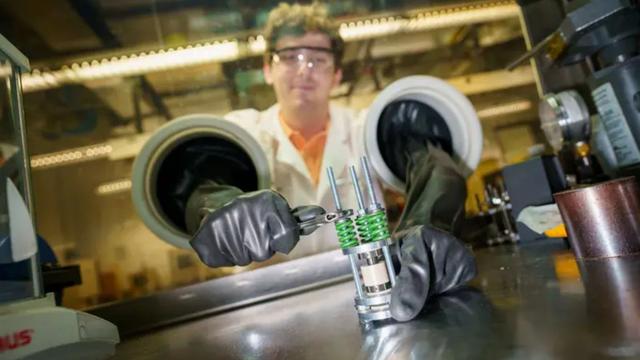
A team of researchers has combined the best battery technologies to create the world’s first anode-free sodium solid-state battery.
The team’s design uses a stable solid electrolyte and pressure to form dense sodium metal. An aluminum current collector ensures efficient, repeatable sodium plating and stripping at high capacities and speeds.
This new type of battery will be less expensive and less harmful to the environment since the anode will be removed, and sodium, which is cheap and plentiful, will be used instead of lithium.
“Although there have been previous sodium, solid-state, and anode-free batteries, no one has been able to successfully combine these three ideas until now,” said Grayson Deysher, a Ph.D. candidate at UC San Diego and first author of the study, in a statement.
According to the team, the innovation can help to create inexpensive, fast-charging, high-capacity batteries for electric vehicles (EVs) and grid storage.
Anode-free battery innovation
Compared to sodium, which makes up 20,000 parts per million of the Earth’s crust, lithium makes up just around 20 parts per million.
The increasing shortage of lithium-ion batteries for computers, phones, and EVs has led to a sharp increase in their prices, making them even more unaffordable.
Sodium is more abundant in the environment and frequently found in ocean water and soda ash mining.
For such an idea to become a reality, the group had to develop a brand-new sodium battery architecture in order to produce a sodium battery with the energy density of a lithium battery.
In conventional batteries, the ions are stored in the anode during the charging process. When the battery is in operation, ions move from the anode to the cathode, or current collector, via an electrolyte, powering cars and other devices in the process.
According to researchers, anode-free batteries eliminate the anode and deposit alkali metal directly onto the current collector, storing the ions there through electrochemical means. Although this method has drawbacks, it offers greater energy density, reduced cell cost, and higher cell voltage.
“In any anode-free battery there needs to be good contact between the electrolyte and the current collector. This is typically very easy when using a liquid electrolyte, as the liquid can flow everywhere and wet every surface. A solid electrolyte cannot do this,” said Deysher.
Liquid electrolytes cause a buildup called solid electrolyte interphase, which steadily consumes the active materials and reduces the battery’s usefulness over time.
Innovative sodium battery design
The team devised an innovative solution by creating a current collector that surrounds the electrolyte instead of the usual approach.
They used aluminum powder, which can flow like a liquid, to make the current collector. During battery assembly, this powder was compressed under high pressure to form a solid current collector while maintaining liquid-like contact with the electrolyte.
According to researchers, this method enables low-cost, high-efficiency cycling, advancing this game-changing technology.
“Sodium solid-state batteries are usually seen as a far-off-in-the-future technology, but we hope that this paper can invigorate more push into the sodium area by demonstrating that it can indeed work well, even better than the lithium version in some cases,” said Deysher.
The team envisions a future in which a variety of clean, affordable batteries store renewable energy tailored to society’s needs.
The details of the research done by members from the UChicago Pritzker School of Molecular Engineering and the University of California San Diego were published in the journal Nature Energy.
